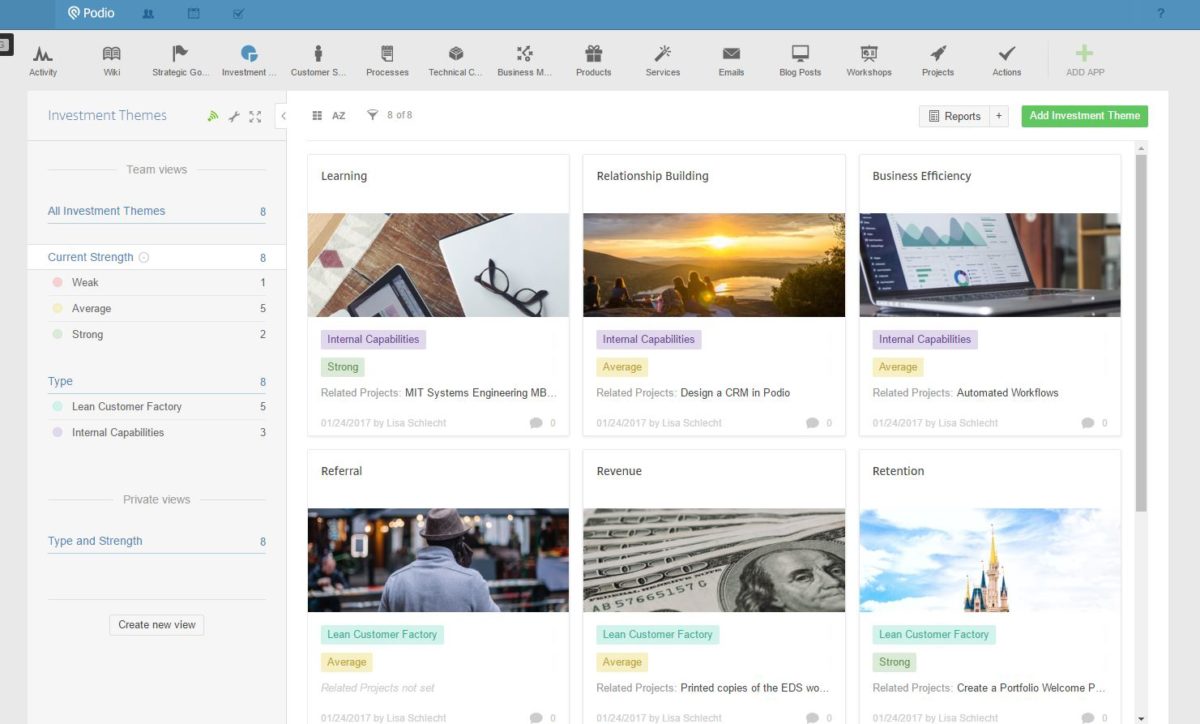

Your calendar is packed with meetings on a variety of topics. You multitask to keep all of your projects moving forward. Everyone’s busy but you generally end the week feeling like you didn’t make enough progress. It feels like you’re constantly negotiating (or fighting) to get anything done.
Sound familiar?
Whether you’re a planning addict or planning adverse, I’ve found that investment themes are the key to balancing productivity, alignment, creativity, and flexibility.
What they are
Investment themes are sometimes referred to as “buckets” of investments. They’re usually a few words or a simple phrase.
From a logistical perspective, they’re essentially tags or labels for your ideas and backlog items. Anything that you’re considering spending resources on. You can use these labels for quick filtering and for creating visual reports about the content of your backlog and roadmap. I also recommend creating a wiki page for each investment theme to house additional information.
For each increment of time (such as releases, months, or quarters), pick a few themes and only work on items related to those themes. That means complete immersion and focusing on the metrics and projects related to that theme. Any new insights outside of that theme should be captured somewhere but give yourself permission to say no to spending a lot of energy on items that just don’t fit the current theme.
Why they’re helpful
The biggest value of using investment themes is improving balance and focus.
Allocating resources to investment themes helps leaders provide strategic direction without specifically prescribing how the work is done. For example, if you want to devote 30% of your resources to expanding your client base and 70% to operations then each group can choose how to best “fill up” their investment bucket. The more themes that you have for each month, the more context switching needs to occur and the harder it is to align each team member’s priorities.
By creating reports of the planned vs. executed work within each theme, you can also better see where you’re spending a lot of time and which areas are being ignored. You could color code your calendar to view at a glance how you’re allocating your week or month to different themes.
Choosing a set of investment themes can also help you organize your research and ideas. For example, one theme could be improving customer service. You could create a wiki page or document to store all of the information you’ve collected about your current customer service plus ideas to improve it. Then use your strategic goals to decide which notes to promote to experiment, epic or project status.
By picking only a few investment themes per quarter or release, you can stay focused on the context, and flexible with your tactics. Since you’re constraining the scope of your research and discovery (to the theme), there will be more free time and energy to work on experimentation and solutioning. Plus, because you’re all working on the same theme, it will be easier to share and apply knowledge across teams. Teams no longer need to negotiate conflicting priorities because everyone is working on determining how they can best serve the common theme.
The urgent requests will still come. A theme gives you the space to say no. Or to reframe the solution to serve your current theme.
How to choose investment themes
Unlike strategic goals, epics, or features, investment themes don’t need to have an end point. There’s no target metric like for strategic goals, or a set scope for a project. Instead, they are themes that could stretch for years or be abandoned after a couple of releases, depending on what they are. Like the name implies, these themes cover areas of “investment” of time, money, or other resources.
For example, improving customer satisfaction could be a strategic goal if you’re trying to reach a certain average score on your feedback surveys. Customer satisfaction could be an investment theme and a place to track all initiatives related to improving the customer experience. A specific project like building a welcome kit for new members could be a project within the investment theme, with the goal of contributing to the customer satisfaction strategic goal.
There are no specific rules around investment themes and you can change them as your business changes. Feel free to be creative with them. However, here are some examples to help you get started.
I like to use these investment themes in my business:
- Acquisition
- Activation
- Retention
- Revenue
- Referral
- Business efficiency
- Relationship building
- Learning
The first five are related to what Ash Maurya describes as the Lean Customer Factory. The last three are for work that needs to happen behind the scenes to better support the externally facing Lean Customer Factory. This structure helps me organize the information I’m finding and stay focused on the “bottleneck” areas of the business to help it run more smoothly. I find this set of themes helpful for setting up and growing a new organization. Each category is wide enough to provide room for creativity but narrow enough to see an impact if you focused on that theme for a month or a quarter. Each also has a clear purpose, which helps for staying motivated.
For each theme, I track a brief description of what it represents as well as some metrics related to that theme. I also keep a list of project ideas and link any related projects that are in-flight. Lastly, I include a simple “current strength” indicator of weak, average, or strong to remind myself at a glance which themes need more attention. I gauge the current strength based on the number of recent projects related to that theme and performance of that theme’s metrics. If the investment theme is related to one of my strategic goals then I’ll link those pages together. Podio is my current favorite tool for doing this, but you can easily set up something similar in many other tools like JIRA, Confluence, or Asana by adding custom fields and links.

Some other ways to define your investment themes:
- Customer value
- Back-end business value
- Operations
- Platform work
Or:
- Growth
- Customer satisfaction
- Employee satisfaction
Or:
- Client work
- Marketing
- Products/services
- Admin
- Planning
- Infrastructure
- Relationship building
Or:
- Primary customer base
- Secondary customer base
- Internal facing
Or:
- Value stream A
- Value stream B
- Shared capability C
- Shared capability D
In terms of how many themes to pick for each increment, it depends on your resources. The less time or people you have, the fewer you can tackle at once to make significant progress. If you have dedicated teams or time blocks for each theme then you can get away with more, but be careful of dependencies. For example, if a team working on system infrastructure also needs to support business features, then they’ll actually be dividing their time across multiple themes.
If you’re not sure which theme to pick, focus on ones related to your strategic goals, or the most problematic or vulnerable part of your business. You could try ranking them with your custom value framework. For most organizations, picking any area will provide more momentum than continuing to try to move down 20 paths at once.
Investment themes are simple and powerful. A single phrase can help communicate current priorities and align a large group of people without needing to know the specifics. They’re a great way to deal with overwhelm and shiny object syndrome without losing the ability to see the big picture.
Do you apply investment themes in your work and life? What was your experience implementing them?